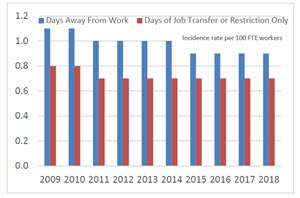
Most Workplace Injury and Illness Rates Unchanged in 2018

There were 2.8 million nonfatal workplace injuries and illnesses reported by private industry employers in 2018. The overall numbers and incidence rate are unchanged from 2017, but the private retail sector reported increases in both the number and rate of workplace injury and illness cases. These are estimates from the Bureau of Labor Statistics Survey of Occupational Injuries and Illnesses (SOII).
This is the first year since 2012 that the TRC rate did not decline. The incidence rates for days away from work (DAFW) cases and for days of job transfer and restriction only (DJTR) cases also were unchanged from 2017.
Highlights from the 2018 Injury and Illness data:

Incidence rates of days away from work cases and job transfer or restriction cases in private industry, 2009-2018. Graph and data by BLS.Retail trade was the only private industry sector where the TRC rate increased in 2018, rising from 3.3 cases to 3.5 cases per 100 full-time equivalent (FTE) workers. This was the first increase in the TRC rate in retail trade since the series began in 2003. Retail trade accounted for 14 percent of all injuries and illnesses in private industry in 2018.
- Within private industry, there were 900,380 injuries or illnesses that caused a worker to miss at least one day of work in 2018, essentially unchanged from 2017.
- A total of 333,830 DAFW cases resulted in a visit to a medical facility such as an emergency room or in-patient hospital.
- Nonfatal occupational injuries and illnesses data by industry and case type are available here.
Retail Trade Sector Injury and Illness Cases
The number and rate of nonfatal cases in the private retail trade sector increased in 2018. The number increased 4 percent to 409,900 cases, and the incidence rate increased from 3.3 cases to 3.5 cases per 100 FTE workers. Within the retail trade sector, general merchandise stores reported 96,000 injury or illness cases; food and beverage stores reported 92,600 cases; motor vehicle and parts dealers reported 61,500 cases; and building material and garden supply stores reported 53,800 cases.
Of the 126,850 cases involving days away from work in retail trade in 2018, those resulting from falls, slips, or trips increased to 34,190 cases, an increase of 11 percent from 2017. Cases resulting from contact with objects and equipment increased 10 percent in 2018 to 38,940 cases. These events had a higher rate for workers in the retail trade sector than for workers in private industry in 2018.
Injuries and illnesses in retail trade most often resulted from sprains, strains, and tears, which accounted for 36 percent of DAFW cases. Seventeen percent of these DAFW cases resulted from back injuries.
Injuries and illnesses to retail salespersons accounted for 20 percent of the DAFW cases in retail trade, increasing from 23,240 in 2017 to 25,600 in 2018. First-line supervisors of retail sales workers accounted for another 13 percent (15,940) of the DAFW cases in retail trade.
Emergency Room and Hospital Visits
This is the first year estimates for medical treatment facility visits for nonfatal occupational injuries and illnesses requiring DAFW are available. Of the 900,380 DAFW cases in private industry, 333,830 (37 percent) required a visit to a medical facility. Of these, 294,750 required a trip to the emergency room and did not require hospitalization, and 39,080 cases required in-patient hospitalization, either with or without an ER visit. The median number of days away from work for all private industry cases in 2018 was 8 days. The median number of days away from work for ER visits only was 7 days and the median for in-patient hospitalization was 41 days.

